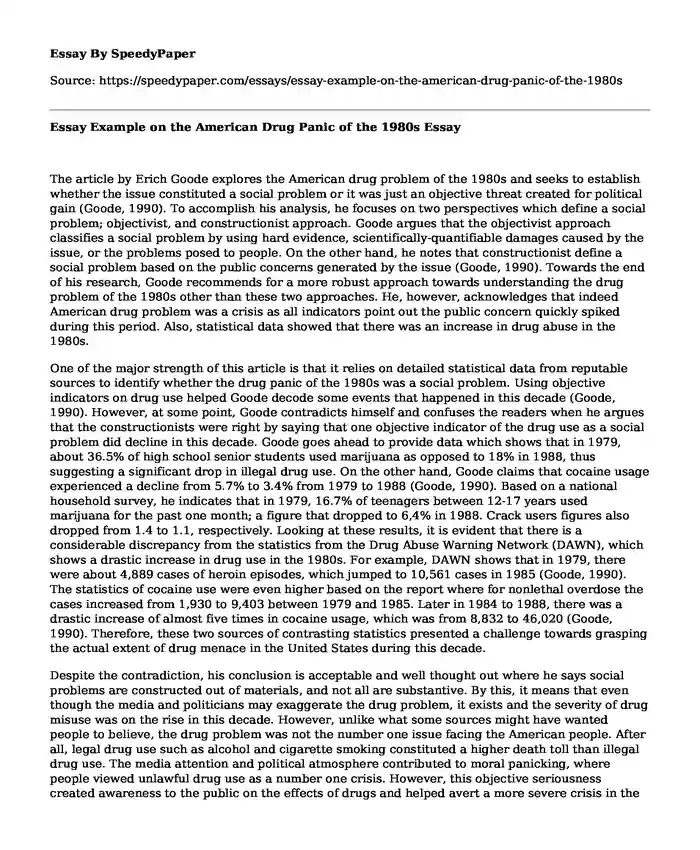
| Type of paper: | Essay |
| Categories: | America Drug abuse Social issue |
| Pages: | 3 |
| Wordcount: | 627 words |
The article by Erich Goode explores the American drug problem of the 1980s and seeks to establish whether the issue constituted a social problem or it was just an objective threat created for political gain (Goode, 1990). To accomplish his analysis, he focuses on two perspectives which define a social problem; objectivist, and constructionist approach. Goode argues that the objectivist approach classifies a social problem by using hard evidence, scientifically-quantifiable damages caused by the issue, or the problems posed to people. On the other hand, he notes that constructionist define a social problem based on the public concerns generated by the issue (Goode, 1990). Towards the end of his research, Goode recommends for a more robust approach towards understanding the drug problem of the 1980s other than these two approaches. He, however, acknowledges that indeed American drug problem was a crisis as all indicators point out the public concern quickly spiked during this period. Also, statistical data showed that there was an increase in drug abuse in the 1980s.
One of the major strength of this article is that it relies on detailed statistical data from reputable sources to identify whether the drug panic of the 1980s was a social problem. Using objective indicators on drug use helped Goode decode some events that happened in this decade (Goode, 1990). However, at some point, Goode contradicts himself and confuses the readers when he argues that the constructionists were right by saying that one objective indicator of the drug use as a social problem did decline in this decade. Goode goes ahead to provide data which shows that in 1979, about 36.5% of high school senior students used marijuana as opposed to 18% in 1988, thus suggesting a significant drop in illegal drug use. On the other hand, Goode claims that cocaine usage experienced a decline from 5.7% to 3.4% from 1979 to 1988 (Goode, 1990). Based on a national household survey, he indicates that in 1979, 16.7% of teenagers between 12-17 years used marijuana for the past one month; a figure that dropped to 6,4% in 1988. Crack users figures also dropped from 1.4 to 1.1, respectively. Looking at these results, it is evident that there is a considerable discrepancy from the statistics from the Drug Abuse Warning Network (DAWN), which shows a drastic increase in drug use in the 1980s. For example, DAWN shows that in 1979, there were about 4,889 cases of heroin episodes, which jumped to 10,561 cases in 1985 (Goode, 1990). The statistics of cocaine use were even higher based on the report where for nonlethal overdose the cases increased from 1,930 to 9,403 between 1979 and 1985. Later in 1984 to 1988, there was a drastic increase of almost five times in cocaine usage, which was from 8,832 to 46,020 (Goode, 1990). Therefore, these two sources of contrasting statistics presented a challenge towards grasping the actual extent of drug menace in the United States during this decade.
Despite the contradiction, his conclusion is acceptable and well thought out where he says social problems are constructed out of materials, and not all are substantive. By this, it means that even though the media and politicians may exaggerate the drug problem, it exists and the severity of drug misuse was on the rise in this decade. However, unlike what some sources might have wanted people to believe, the drug problem was not the number one issue facing the American people. After all, legal drug use such as alcohol and cigarette smoking constituted a higher death toll than illegal drug use. The media attention and political atmosphere contributed to moral panicking, where people viewed unlawful drug use as a number one crisis. However, this objective seriousness created awareness to the public on the effects of drugs and helped avert a more severe crisis in the future.
References
Goode, E. (1990). The American Drug Panic of the 1980s: Social Construction or Objective Threat? International Journal of the Addictions, 25(9), 1083-1098. doi:10.3109/10826089009058874
Cite this page
Essay Example on the American Drug Panic of the 1980s. (2023, Jan 13). Retrieved from https://speedypaper.net/essays/essay-example-on-the-american-drug-panic-of-the-1980s
Request Removal
If you are the original author of this essay and no longer wish to have it published on the SpeedyPaper website, please click below to request its removal:
- Free Essay Containing the Characteristics of a Good Student
- How to Train Others at Work - HRM Essay Example
- Is a Consumer Society a Good Society? Free Essay
- Literary Essay on the Raven by Edgar Allan Poe
- Project Control Procurement - Project Management Essay Sample
- Roman Civilisation Essay Example
- Free Essay. Social Welfare Programs
Popular categories




